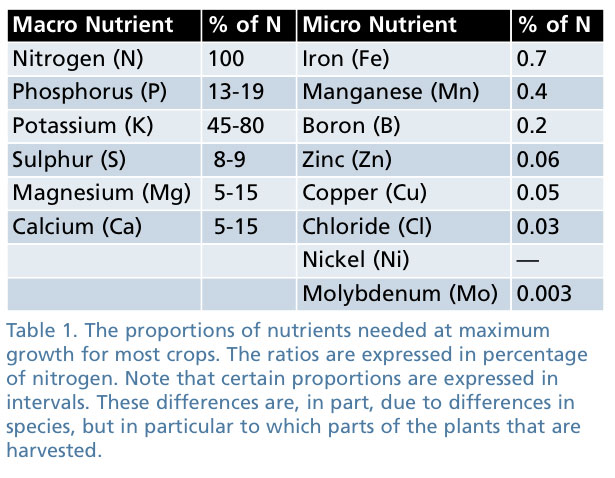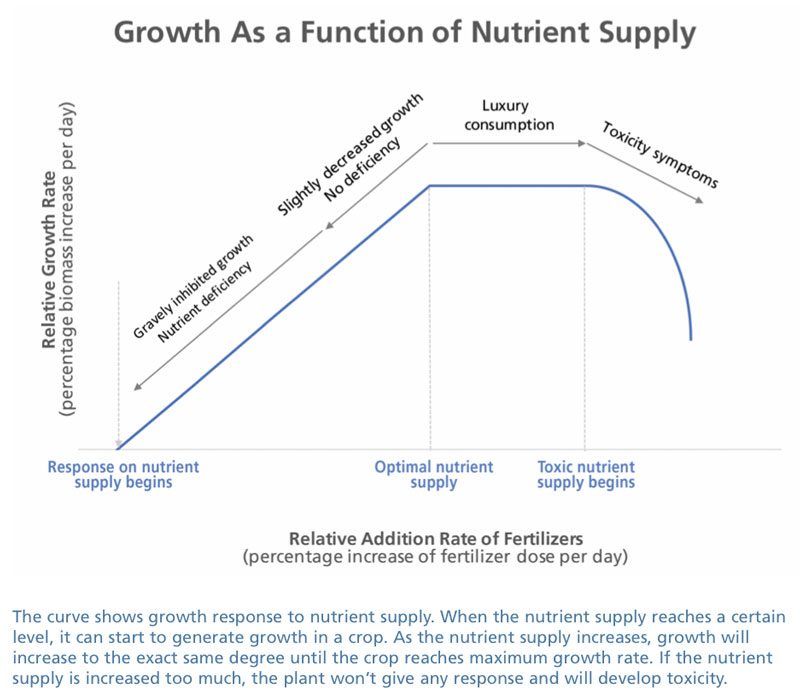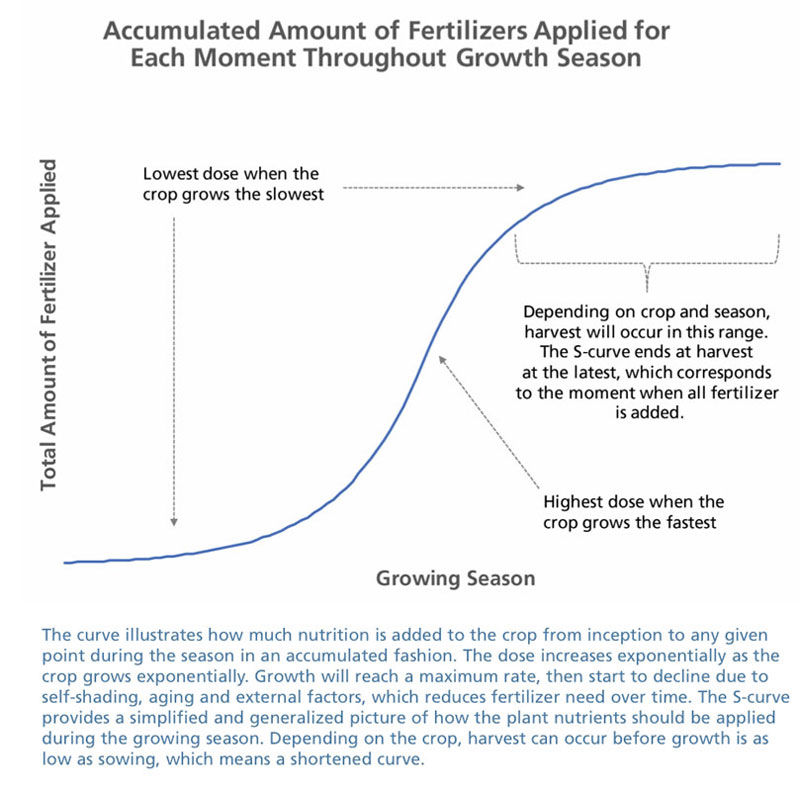6/1/2018
Precision Plant Production
Joachim Nachmansohn
With the background of commercial fertilizers being a limited resource in a world of ever-growing food demand, maximizing fertilizer use efficiency and optimizing plant nutrition have never been more urgent.
At the same time, greenhouse production, vertical growing and automation is constantly gaining relevance, and they’re all production systems in which precision horticulture is a key factor and thus a niche in which optimized plant nutrition is highly relevant. That’s not only due to the nutrition resource being limited, but also because it’s an investment-dense niche, in which all inputs must be weighted carefully from a financial perspective. Also, there’s the importance of preventing environmental pollution from unbalanced fertilization practices.

Fertilizer input is a key aspect
In horticulture, the fertilizer input is one of the central aspects in driving crop growth and development in accordance with the aims of the production, and for this, precision fertigation is usually the standard. At least it should be; not using precision fertigation in a controlled environment production is to not fully utilize the benefits that come with controlling the environmental factors, to say the least.
In other words, from a pure production perspective, a precision application of plant nutrition is one of the most central pillars in optimizing plant production. Implementing precision fertigation is only the first step in reaching optimized nutrition. The next step is to apply it in accordance with the crop demand. Of course, this is what most growers, farmers and researchers try to do. But, from my experience, fertigation is either applied with overly simplified, or overly complicated, approaches when, in fact, it’s neither complicated nor difficult to apply fertigation with extreme accuracy in a very simple and intuitive way.
Demand-driven fertilization
The method/concept of demand-driven fertilization was initially developed by researcher Dr. Torsten Ingestad and his co-workers. He was awarded with the Wallenberg Prize for his path-breaking discoveries. (The Wallenberg Prize is basically a Nobel Prize in forestry/biology, and with similar prestige, the award is administered by the King of Sweden.)
 The concept has optimized production efficiency, lowered fertilizer use, increased crop quantity and quality, and minimized adverse environmental impact in many plant production systems, including already streamlined high-tech-based precision production systems.
The concept has optimized production efficiency, lowered fertilizer use, increased crop quantity and quality, and minimized adverse environmental impact in many plant production systems, including already streamlined high-tech-based precision production systems.
The method involves both a plant nutrition and a fertilizer management concept. In particular, there are two aspects that are unique about the concept: the nutrient ratios and the nutrient delivery model.
All plants need the 14 essential plant nutrients and they need them in specific ratios. As it turned out, these ratios are similar for most crops and throughout their life-cycles. This is because plants overall share very similar physiology, even though they might appear very different to the human eye. Similar physiology means similar nutritional needs. This is particularly true for vegetative growth, as every new-formed cell in a plant basically needs the same thing, in virtually the same ratios. Table 1 illustrates these ratios.
There are some exceptions to this rule, of course; some adjustment needs to be done for some kinds of species. One such example is production in which we harvest tissue mainly generated by sexual reproduction, which is the case in floriculture. In such cases, the demand for potassium will be significantly higher, as such tissue contains more of that nutrient.
Another reason for exceptions from this rule is the quality aspects we aim for in commercial production. However, it’s important to remember that this isn’t an expression of the need of the crop itself, but a demand due to human aims with the production.

Growth capacity
With minor adjustments, every crop has a virtual constant need for all nutrients, in terms of the ratios. What really differs between crops is the total amount of nutrients that they need. This in turn is mainly determined by the growth capacity of the crop.
An easy thing to miss is that all resources flow into the plant and it’s this influx that determines growth and performance of the plant. This is true for nutrients as well. When the flow of nutrients into the plant matches the growth capacity, we enable maximum growth rate.
All plant species grow exponentially when growing unhindered; i.e., the plant increases its biomass with a certain percentage each day up until a certain point, from which self-shading, aging and the decline of the growing season will slow down the growth rate, virtually exponentially, until it reaches the lowest growth rate of the year. This is mainly relevant for perennials.
By matching the additional rate of nutrients with the growth rate, the nutrient supply becomes the driver in plant growth and performance. And by decreasing the additional rate, the growth rate will decrease by the exact same factor.
At maximum growth, all energy from the photosynthesis goes to growth. By slowing down growth, resources from the photosynthesis are allocated to other things, such as flowering, fruiting, chemical defense, etc. In this way, you can control both the quantity and quality of the plant part that you want to harvest.
Benefits of the concept
The benefits of the concept are many, and often superior. For instance, it provides the possibility to control/manipulate which part of the plant you want to benefit depending on crop and production goals. It can enable maximum growth rate or it can enhance flowering and fruiting. You can choose between benefiting the root or the shoot.
At the same time, it lowers fertilizer use and adverse environmental impact by maximizing fertilizer use efficiency. Not only will the crop consume all of the added nutrients, it will enjoy maximum utility of the amount that it takes up. In other words, it will need less for more. It also prevents problems from malnutrition, as the crop is given all of the nutrients it needs on demand.
The concept simplifies the production; the principles are simple and universally applicable, and can easily be adjusted for any crop and production goal. This is important, as growers benefit from simplifications in their production systems.
Applicability and practical instructions
Greenhouse production with precision technology is one of the most relevant contexts for utilizing demand-driven fertilization. Drip-fertigation provides the highest precision of the concept, but it can also be applied in systems with lower precision; as long as regular irrigation is a part of the production, the concept can be used with high satisfaction.
From a nutritional perspective, it’s optimal to add nutrients with every irrigation. Depending on irrigation frequency, the dose will vary, as all the nutrients that are added on each occasion is exactly enough to suffice until the next occasion. Regardless of the frequency, the dose should increase with the same percentage rate as the daily increase in biomass.
If the crop has a long growth season, growth rate will decline in conjunction with the decreasing light intensity and hours of daylight of the growth season. If so, the additional rate should decrease accordingly. This is also dependent on the level of control of the input from artificial light. If the controlled environment only has artificial light, there will be virtually no decrease in the growth rate.
Exact doses are determined by the total amount of nutrients that are needed for a whole production cycle and will simply be distributed according to the pattern explained.
To give the plant what it needs, when it needs it and in correct doses, not only optimizes the production and maximizes the fertilizer use efficiently, it increases profitability. If the inputs are lower while producing a crop of higher quality, in a more rationalized system, it will clearly benefit the financial aspects of the production. That the concept also is the best option for the environment is all the better. GT
Joachim Nachmansohn works internationally as a fertilizer and soil and water management expert. Through his company, Nachmansohn Consulting & Co., he, among other things, works with spreading accurate knowledge and skills on how to improve fertilizer use. His unique specialty is Demand-Driven Fertilization. He can be reached at consulting@joachimnachmansohn.com or visit www.joachimnachmansohn.com.